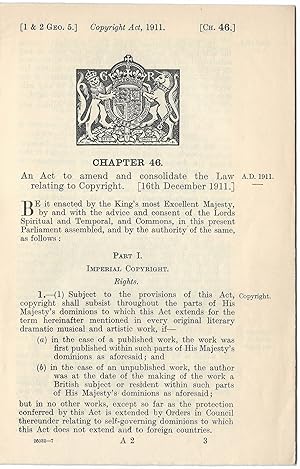Beschreibung
An Exceptional Collection of 70 Parliamentary Documents Relating to Copyright Law in Great Britain and its Colonies: 26 Parliamentary Bills, 43 Parliamentary Acts, and 1 Parliamentary Paper from the reigns of Charles II, William and Mary, Anne I, George II, George III, George IV, William IV, Victoria, and George V. London: 1662-1911. Folio and octavo. First editions. Woodcut and engraved Royal coats of arms, headpieces and ornamental initial letters. Printed in Old English Black Letter font up to 1793 and in Roman Letter font thereafter, on laid or wove watermarked paper. Neatly extracted from bound volumes and expertly mended. In very good to fine condition. The LAW OF COPYRIGHT granted the creator of an original work (or their designated assignee) the exclusive legal right to print, publish, copy, sell, distribute, and perform their creative work for a designated period of time. The creative work, considered the intellectual property of the author, could be literary, artistic, dramatic, educational, or musical in nature. The concept of copyright came into being after the printing press was developed in Europe and adopted widely in the fifteenth and sixteenth centuries. In England, copyright law was developed largely in response to the printing and distribution of scandalous publications that were offensive to the crown and government. Copyright had its origins in the Licensing Act, 1662 which required that all intended publications be registered and regulated by the government-sanctioned Stationers' Company (a guild of printers that were given the authority to print and censor literary works - originally formed in 1403 and awarded a Royal charter in 1557). The Stationers' Company thus held a monopoly over the publishing industry, and was responsible for making and enforcing regulations. COPYRIGHT WAS FURTHER DEVELOPED by the COPYRIGHT ACT, 1710 which provided the FIRST LEGISLATION TO PROTECT CREATIVE WORKS IN ENGLAND AND SCOTLAND. The new law provided for a copyright term of 14 years (with provisions for renewal) during which only the author and licensed printers could publish the author's creations. If the work had been published prior to the enactment of the Copyright Act, 1710 then copyright was protected for 21 years. In time, copyright was expanded to literary, dramatic, artistic works (including engravings, prints, lithographs, sculptures, busts, paintings, drawings, and photographs), utilitarian and ornamental designs, educational works, and musical compositions. The Copyright Act, 1814 further broadened rights for authors, and set a copyright term of either 28 years or the natural life of the creator (whichever was longer). The 1814 Act was also the FIRST LEGISLATION TO STATE THAT WOMEN HAD OWNERSHIP OF THEIR COPYRIGHT. The Copyright Act, 1842 extended the period of copyright to the natural life of the creator plus 7 years, or for 42 years from first publication, whichever was longer. The International Copyright Act, 1886 provided protection for authors among the countries who signed the 1886 Berne Convention for the Protection of Literary and Artistic Works. The Copyright Act, 1911 eliminated the need for registration at the Stationers' Hall, and provided that copyright was automatically established upon the creation of a work. As well, the copyright term was designated to be the natural life of the creator plus 50 years. An outstanding collection on Copyright Law. A full listing of the collection is available. Bestandsnummer des Verkäufers 252
Verkäufer kontaktieren
Diesen Artikel melden
![]()




